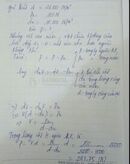Hãy nhập câu hỏi của bạn vào đây, nếu là tài khoản VIP, bạn sẽ được ưu tiên trả lời.

\(\frac{x^2+2x}{2x+10}+\frac{x-5}{x}+\frac{50-5x}{2x\left(x+5\right)}=\frac{x^2+2x}{2\left(x+5\right)}+\frac{x-5}{x}+\frac{50-5x}{2x\left(x+5\right)}=\)
\(=\frac{x\left(x^2+2x\right)+2\left(x+5\right)\left(x-5\right)+50-5x}{2x\left(x+5\right)}=\frac{x^3+2x^2+2x^2-50+50-5x}{2x\left(x+5\right)}=\frac{x^3+4x^2-5x}{2x\left(x+5\right)}=\)
\(=\frac{x\left(x^2+4x-5\right)}{2x\left(x+5\right)}=\frac{x\left(x^2+4x-5\right)}{2x\left(x+5\right)}=\frac{x\left(x^2-1+4\left(x-1\right)\right)}{2x\left(x+5\right)}=\frac{x\left(x-1\right)\left(x+5\right)}{2x\left(x+5\right)}\)
a/ Để biểu thức xác đinh => 2x(x+5) khác 0 => x khác 0 và x khác -5
b/ Gọi biểu thức là A. Rút gọn A ta được:
\(A=\frac{x\left(x-1\right)\left(x+5\right)}{2x\left(x+5\right)}=\frac{x-1}{2}\left(x\ne0;x\ne-5\right)\)
A=1 => x-1=2 => x=3
c/ A=-1/2 <=> x-1=-1 => x=0
d/ A=-3 <=> x-1=-6 => x=-5

a) Để giá trị biểu thức 5 – 2x là số dương
<=> 5 – 2x > 0
<=> -2x > -5 ( Chuyển vế và đổi dấu hạng tử 5 )
\(\Leftrightarrow x< \frac{5}{2}\)( Chia cả 2 vế cho -2 < 0 ; BPT đổi chiều )
Vậy : \(x< \frac{5}{2}\)
b) Để giá trị của biểu thức x + 3 nhỏ hơn giá trị biểu thức 4x - 5 thì:
x + 3 < 4x – 5
<=< x – 4x < -3 – 5 ( chuyển vế và đổi dấu các hạng tử 4x và 3 )
<=> -3x < -8
\(\Leftrightarrow x>\frac{8}{3}\)( Chia cả hai vế cho -3 < 0, BPT đổi chiều).
Vậy : \(x>\frac{8}{3}\)
c) Để giá trị của biểu thức 2x +1 không nhỏ hơn giá trị của biểu thức x + 3 thì:
2x + 1 ≥ x + 3
<=> 2x – x ≥ 3 – 1 (chuyển vế và đổi dấu các hạng tử 1 và x).
<=> x ≥ 2.
Vậy x ≥ 2.
d) Để giá trị của biểu thức x2 + 1 không lớn hơn giá trị của biểu thức (x - 2)2 thì:
x2 + 1 ≤ (x – 2)2
<=> x2 + 1 ≤ x2 – 4x + 4
<=> x2 – x2 + 4x ≤ 4 – 1 ( chuyển vế và đổi dấu hạng tử 1; x2 và – 4x).
<=> 4x ≤ 3
\(\Leftrightarrow x\le\frac{3}{4}\)( Chia cả 2 vế cho 4 > 0 )
Vậy : \(x\le\frac{3}{4}\)

a) \(Q=\frac{x+3}{2x+1}-\frac{x-7}{2x+1}\left(ĐK:x\ne-\frac{1}{2}\right)\)
\(=\frac{x+3-x+7}{2x+1}=\frac{10}{2x+1}\)
b) Để Q nguyên \(\Leftrightarrow\frac{10}{2x+1}\in Z\)
=> \(2x+1\inƯ\left(10\right)\)
=> \(2x+1\in\left\{1;-1;2;-2;5;-5;10;-10\right\}\)
Ta có bảng sau:
| 2x+1 | 1 | -1 | 2 | -2 | 4 | -4 | 10 | -10 |
| x | 0 | -1 | \(\frac{1}{2}\) (loại) | \(-\frac{3}{2}\)(loại) | \(\frac{3}{2}\)(loại) | \(-\frac{5}{2}\)(loại) | \(\frac{9}{2}\)(loại) | \(-\frac{11}{2}\)(loại) |
Vậy \(x\in\left\{0;-1\right\}\)

Bài 1
Ta có : \(\frac{2x+2}{x^2-1}=0\)ĐK : \(x\ne\pm1\)
\(\Leftrightarrow2x+2=0\Leftrightarrow x=-1\)( ktm )
Bài 2 :
Ta có : \(\frac{2x+3}{-x+5}=\frac{3}{4}\)ĐK : \(x\ne5\)
\(\Leftrightarrow8x+12=-3x+15\Leftrightarrow11x=3\Leftrightarrow x=\frac{3}{11}\)
Vậy phương trình có tập nghiệm là S = { 3/11 }

A/ Theo đề ta có \(\frac{x}{2}-\frac{x-5}{10}\) không âm
\(\Rightarrow\frac{x}{2}-\frac{x-5}{10}\ge0\)
\(\Rightarrow\frac{5x}{10}-\frac{x-5}{10}\ge0\)
\(\Rightarrow\frac{5x-x+5}{10}\ge0\)
\(\Rightarrow\frac{4x+5}{10}\ge0\)
\(\Rightarrow4x+5\ge0\)
\(\Rightarrow4x\ge-5\)
\(\Rightarrow x\ge-\frac{5}{4}\)
\(\Rightarrow S=\left\{x\in R;x\ge-\frac{5}{4}\right\}\)
B/ theo đề ta có \(\frac{2x-3}{8}-\frac{x-5}{12}\) không dương
\(\Rightarrow\frac{2x-3}{8}-\frac{x-5}{12}\le0\)
\(\Rightarrow\frac{3\left(2x-3\right)}{24}-\frac{2\left(x-5\right)}{24}\le0\)
\(\Rightarrow\frac{6x-9}{24}-\frac{2x-10}{24}\le0\)
\(\Rightarrow\frac{6x-9-2x+10}{24}\le0\)
\(\Rightarrow\frac{4x-1}{24}\le0\)
\(\Rightarrow4x-1\le0\)
\(\Rightarrow4x\le1\)
\(\Rightarrow x\le\frac{1}{4}\)
\(\Rightarrow S=\left\{x\in R;x\le\frac{1}{4}\right\}\)



a, \(\frac{2x-1}{3}+1=\frac{2x-1}{3}-11\)
<=> \(\frac{2x-1}{3}+1-\frac{2x-1}{3}+11=0\)
<=> \(\frac{2x-1-2x-1}{3}+12=0\)
<=> \(\frac{0x-2+36}{3}=0\)
<=> \(0x-2=0\) (Vô lý) => pt vô nghiệm
b, \(\frac{3-2x}{5}\ge0\) <=> \(3-2x\ge0\)
<=> \(x\le\frac{3}{2}\)